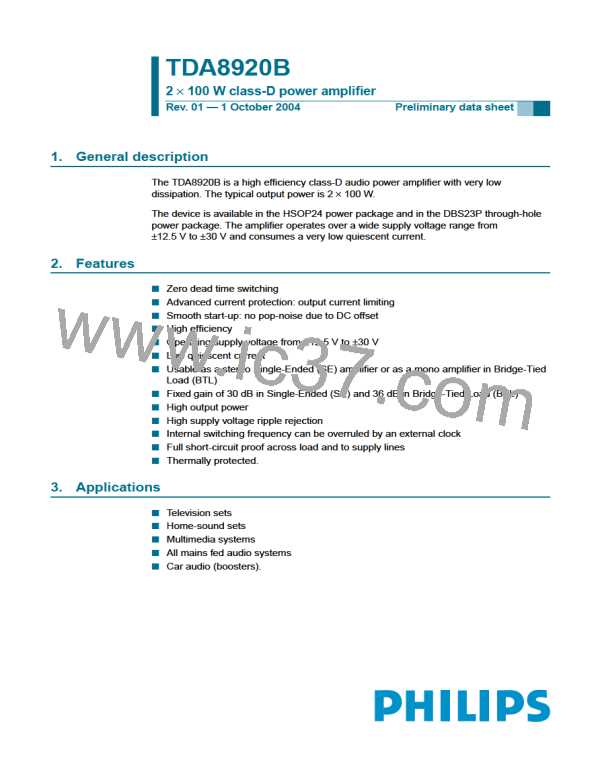TDA8920B
Philips Semiconductors
2 × 100 W class-D power amplifier
12.2 Stereo and dual SE application
Table 9:
Stereo and dual SE application characteristics
VP = ±27 V; RL = 4 Ω; fi = 1 kHz; fosc = 317 kHz; RsL < 0.1 Ω [1]; Tamb = 25 °C; unless otherwise specified.
Symbol
Parameter
Conditions
Min
Typ
Max
Unit
[2]
[2]
[2]
[2]
[3]
Po
output power
RL = 3 Ω; VP = ±27 V
THD = 0.5 %
THD = 10 %
-
-
87
-
-
W
W
110
RL = 4 Ω; VP = ±27 V
THD = 0.5 %
THD = 10 %
-
-
69
86
-
-
W
W
RL = 6 Ω; VP = ±27 V
THD = 0.5 %
THD = 10 %
-
-
48
60
-
-
W
W
RL = 8 Ω; VP = ±27 V
THD = 0.5 %
THD = 10 %
-
-
36
45
-
-
W
W
THD
total harmonic distortion
Po = 1 W
fi = 1 kHz
-
0.02
0.03
30
0.05
-
%
fi = 6 kHz
-
%
Gv(cl)
closed loop voltage gain
29
31
dB
[4]
SVRR
supply voltage ripple rejection
operating
fi = 100 Hz
-
55
50
55
80
68
-
-
-
-
-
dB
dB
dB
dB
kΩ
fi = 1 kHz
40
-
[4]
[4]
mute; fi = 100 Hz
standby; fi = 100 Hz
-
Zi
input impedance
45
Vn(o)
noise output voltage
operating
Rs = 0 Ω
mute
[5]
[6]
[7]
-
-
-
-
-
-
210
160
70
-
µV
µV
dB
dB
µV
dB
-
αcs
channel separation
-
∆Gv
channel unbalance
-
1
-
[8]
Vo(mute)
CMRR
output signal in mute
common mode rejection ratio
100
75
Vi(CM) = 1 V (RMS)
-
[1] RsL is the series resistance of inductor of low-pass LC filter in the application.
[2] Output power is measured indirectly; based on RDSon measurement. See also Section 13.3.
[3] Total harmonic distortion is measured in a bandwidth of 22 Hz to 20 kHz, using AES17 20 kHz brickwall filter. Maximum limit is
guaranteed but may not be 100 % tested.
[4] Vripple = Vripple(max) = 2 V (p-p); Rs = 0 Ω.
[5] B = 22 Hz to 20 kHz, using AES17 20 kHz brickwall filter.
[6] B = 22 Hz to 22 kHz, using AES17 20 kHz brickwall filter; independent of Rs.
[7] Po = 1 W; Rs = 0 Ω; fi = 1 kHz.
[8] Vi = Vi(max) = 1 V (RMS); fi = 1 kHz.
9397 750 13356
© Koninklijke Philips Electronics N.V. 2004. All rights reserved.
Preliminary data sheet
Rev. 01 — 1 October 2004
14 of 34

 NXP [ NXP ]
NXP [ NXP ]